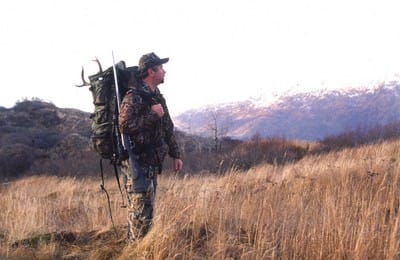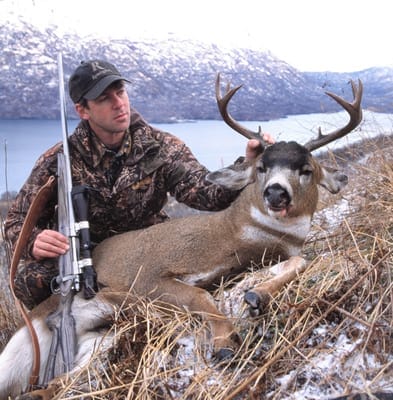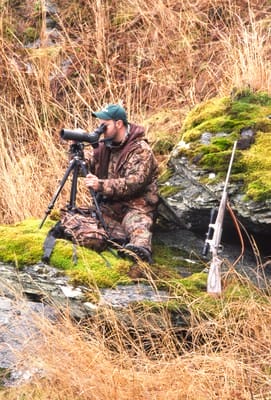
Deer tracks were generous in the fresh dusting of snow. Dean Capuano, public relations manager for Swarovski Optik, agreed that it was just a matter of time before we had our first encounter with a Kodiak Island blacktail deer. The two of us were 600 feet above Uyak Bay, a long, narrow cove on the northwest side of Kodiak Island and one of the hunting areas for outfitter Mike Flores. But before we spotted our first deer of the week, we found ourselves standing over a bear track as big as a dinner plate. Capuano and I looked at each other with a mix of awe and subdued fear. We were here to hunt blacktail deer, but the track was an ominous reminder that we weren’t the only hunters on the island.
As a transport guide, Flores is prohibited from serving as an actual hunting guide so Capuano and I were on our own in bear country. He can offer advice—don’t stick around after you field dress your deer—and hunting tips, but his services end at the beach where he drops you off for the day’s hunt. He does, however run a tight base camp, a 47-foot boat (two if he has enough hunters) and a capable crew that takes care of food (including crab legs pulled straight from the ocean) and other vital necessities.

The actual hunting is entirely up to you. Thankfully, blacktails aren’t particularly difficult to hunt. Pressure is virtually non-existent where Flores hunts so Kodiak’s deer haven’t developed the skittish characteristics common among whitetails. We walked right into several does the first day, all of which stood their ground and stared at us as we studied them for antlers. The bucks, however, are a little more evasive, but after getting a feel for the land and the habits of the island’s blacktails, Capuano and I felt good about our chances the second day.
Just minutes after we climbed a hill off the beach on the second morning I spotted a doe feeding in an opening between alder thickets on a steep slope above us. Another appeared higher and as we continued to glass, more deer revealed themselves. We sat for an hour and swept our binoculars across every opening and into every patch of cover we could see, but the two bucks that were here yesterday were nowhere on this cold morning. We grabbed our gear and hiked up and over a steep hill, inspecting every suspicious clump or dark patch we could see as we moved.
“There’s a buck. It’s a good one,” said Capuano. He pointed to the top of the ridge high above us. I spotted the buck, antlers and all, as soon as Capuano lifted his arm.

Capuano pulled his rangefinder from his pack, squeezed a button and pegged the deer at just over 600 yards, too far for a safe shot. We studied the terrain and mapped out a route that would take us straight up the side of a steep hill, one that was covered with thick grass, alder bushes and thorn-covered canes.
When we came to the knob that served as our landmark the buck was standing in the same area and only 100 yards away. His head was turned back toward us, his ears perked and his eyes focused on Capuano and me.
“Busted,” I thought, expecting the deer to drop off the side of the hill and disappear forever. But it hesitated.
As the buck took that last fatal look, I squeezed off a round from my Remington 700. The deer rolled down the steep hill and came to rest 50 feet from where it last stood. It was over as quick as it started and Capuano and I immediately shifted our attention to the thought of bears. Would the shot serve as a dinner bell? We didn’t wait to find out. We snapped a few pictures, field dressed the deer in a matter of minutes and took off toward the beach, glancing back behind us as we dropped off the hill.
For more information, visit www.ninilchik.com



